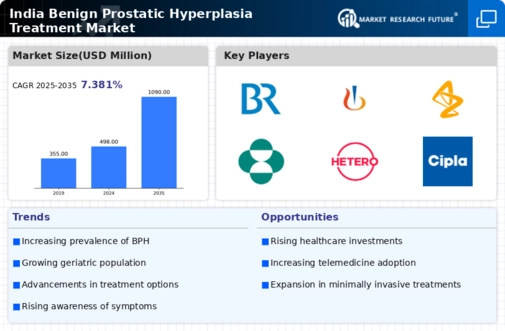Increasing Aging Population
The benign prostatic-hyperplasia-treatment market is experiencing growth due to the increasing aging population in India. As men age, the prevalence of benign prostatic hyperplasia (BPH) rises significantly, with studies indicating that nearly 50% of men aged 50 and above may experience symptoms. This demographic shift is expected to drive demand for effective treatment options. The Indian population aged 60 and above is projected to reach 300 million by 2050, creating a substantial market for BPH treatments. Healthcare providers are likely to focus on developing therapies that cater to this growing segment, thereby enhancing the benign prostatic-hyperplasia-treatment market. Furthermore, the rise in awareness regarding prostate health among older adults is anticipated to contribute to increased consultations and treatment uptake.
Rising Awareness and Education
There is a notable increase in awareness and education regarding benign prostatic hyperplasia among the Indian population. Campaigns aimed at educating men about prostate health and the symptoms of BPH are becoming more prevalent. This heightened awareness is likely to lead to earlier diagnosis and treatment, positively impacting the benign prostatic-hyperplasia-treatment market. Surveys indicate that approximately 60% of men are now more informed about BPH compared to previous years. Furthermore, healthcare providers are increasingly emphasizing the importance of regular check-ups for men over 50, which may result in a higher rate of consultations and treatment initiation. As awareness continues to grow, the market is expected to benefit from an influx of patients seeking effective management options.
Advancements in Medical Technology
Technological advancements are playing a pivotal role in shaping the benign prostatic-hyperplasia-treatment market. Innovations in minimally invasive surgical techniques, such as laser therapy and transurethral resection of the prostate (TURP), are gaining traction among healthcare professionals. These methods offer reduced recovery times and lower complication rates compared to traditional surgeries. The market is witnessing a surge in the adoption of these advanced technologies, with a reported increase of 20% in procedures performed annually. Additionally, the integration of robotic-assisted surgeries is expected to further enhance treatment outcomes. As hospitals and clinics in India invest in state-of-the-art equipment, the benign prostatic-hyperplasia-treatment market is likely to expand, providing patients with more effective and safer treatment options.
Government Initiatives and Support
Government initiatives aimed at improving healthcare access and affordability are significantly influencing the benign prostatic-hyperplasia-treatment market. Various programs are being implemented to enhance healthcare infrastructure, particularly in rural areas where access to urological care may be limited. The Indian government has allocated substantial funding to improve healthcare services, which is likely to facilitate better access to BPH treatments. Additionally, public health campaigns promoting prostate health are expected to encourage more men to seek treatment. With the government's commitment to enhancing healthcare delivery, the benign prostatic-hyperplasia-treatment market is poised for growth as more patients gain access to necessary therapies.
Increase in Lifestyle-Related Health Issues
The rise in lifestyle-related health issues among the Indian population is contributing to the growth of the benign prostatic-hyperplasia-treatment market. Factors such as obesity, sedentary lifestyles, and poor dietary habits are linked to an increased risk of developing BPH. Studies suggest that men with obesity are 30% more likely to experience prostate enlargement. As lifestyle-related health concerns become more prevalent, the demand for effective BPH treatments is expected to rise. Healthcare professionals are likely to focus on lifestyle modification as part of treatment plans, which may further drive the market. The benign prostatic-hyperplasia-treatment market is thus positioned to expand as awareness of these connections grows.























Leave a Comment